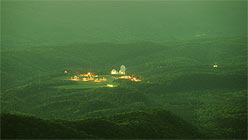Trevor Paglen’s new show, Unhuman, at Altman Seigel Gallery is beautiful and terrifying. Paglen, a trained geographer, has long been using photography as a tool to explore the hidden world of the United States military and intelligence. This show, while no different in scope from Paglen’s past work, has deep range and is his most successful yet. Consisting of only nine pieces, all photographs and one video, Unhuman takes a less explicit — and more seductive — approach to depicting clandestine machinery and defense systems that are otherwise invisible to us.
One of the most effective motifs in the show are Paglen’s large-scale skyscapes. The images, some as tall as 5 feet, are lush enough to resemble William Turner paintings, and a few are completely abstract. If not for some of the furtive content lurking in the surrounding photographs (military planes and secret bases deep in the landscape), these images could easily read as educated darkroom experiments with light and color.
Perhaps the most striking of the skyscapes is The Fence (Lake Kickapoo, Texas), which is the colloquial name for the vast, electromagnetic border surrounding the United States that serves as an invisible warning system designed to detect foreign missiles. In order to photograph the powerful radar system, Paglen shifted its light frequencies to a visible spectrum. The resulting image is full of fiery warm tones, bleeding into one other: reds, oranges and yellows, both verdant and haunting. The four foot tall photograph could just as well be capillaries pumping blood as a vision of all the world afire.

“The Fence (Lake Kickapoo, Texas),” Trevor Paglen, 2010.
In a slight shift in tone for Paglen, the show includes a video Drone Vision, along with a series of six small, gold-toned albumen prints entitled Time Study (Predator; Indian Springs Nevada). Both picture drones flying above the desert, although the video is found footage from American fighter pilots. The shift in format (to video and smaller, tinted prints) as well as source (appropriated material) is a welcome one; these two unexpected pieces ground the other photographs, which alone run the risk of being overcome by their own seductive qualities.


